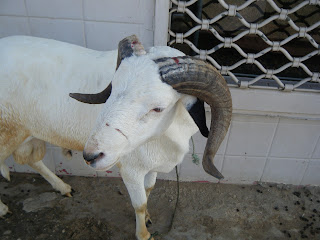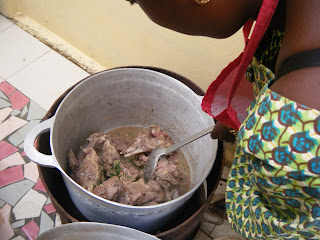This next post will unequivocally make my blog a food blog. However, I need to get better at taking pictures of food, if I really want to invest in this, because the photos to follow do not do the food justice (if I do say so myself). I was a bit hesitant trying to host a Thanksgiving meal in Senegal for a couple reasons. One, I really wasn't sure if what we'd try to make would work given the ingredients we have in Senegal. Second reason I hesitated - I wasn't sure that, even with the proper ingredients, I could cook a Thanksgiving meal! Sure, maybe with my mom and grandmother around I could feel a bit more self-assured, but that is a lot of food to coordinate. In any case, despite my worries, I think my roomate, a few other girls, and I did manage to pull off something quite nice. So here's a recount of Thanksgiving à la mode Senegalaise.
My roommate Giulia and I decided we were going to try a modest Senegalese Thanksgiving meal because we both love to cook and eat and we knew of a couple other American women who wanted to cook a Thanksgiving meal but were living in host families and didn’t have access to a kitchen. This was the Monday before Thanksgiving. By Wednesday evening, 16 people had RSVP’d – how this happened, we’re still not quite sure.
So, Thanksgiving morning began like I’m sure it begins in many American homes. Giulia and I went to the market to get our “turkey.” And by this I mean, Giulia and I went to the sprawling, open-air market called Tilène and negotiated for 3 live chicken. Actually, Giulia offered me up to the vendor as a second wife for $2 off the price of the chicken – what a good friend. We then watched our chicken be carted away and quickly become no longer alive. For 200CFA/chicken (about 50 cents) a couple men plucked, cleaned, and bagged our Thanksgiving feast and we were on our way. Oh I forgot to mention that our chickens came included with a series of eggs inside of them – including one that was about ready to come out, shell and all! The next stop: finding a substitute for pumpkin for the pumpkin pie. Fortunately, there is a type of orange squash in Senegal called “naadjo” that everyone puts in the national dish ceebu jen, so we thought, why not “naadjo pie?” After finding half a large “naadjo” for about $3, we moved onto our Senegalese contribution to the meal: “sauce feuilles” (sauce and greens). Giulia had an idea how to make this dish; I was totally clueless. So we asked the woman we were buying the greens from, who elaborated out the recipe to us in very precise Wolof, that was not very precisely understood by us (thank God she caught on to how clueless we were despite our nodding and used lots of large gestures). Feeling quite excited and having basically chatted up the whole market in our quest for strange food substitutes for Thanksgiving, we headed home.
What proceeded was what I like to think of as Tabaski, Take 2, except swap out the large sheep for 3 stuffed chickens. I spent a couple hours wrestling with the now thoroughly dead chickens, creating a stuffing out of dried and hand-smashed baguette, and filling the birds. Giulia basically tackled the rest of the dishes. Then we had a few American women come over and take a gander at green bean casserole, mashed potatoes, and apple crisp. Things were going quite well until our oven decided that it was too hot and no longer wanted to work. For a brief moment there, Giulia and I envisioned serving our guests half cooked chicken and slowly watching them all get the nasty little Salmonella stomach bug I had a few weeks ago. But in true Thanksgiving and Senegalese fashion, the boutiquiers, the men that run the corner shops that are found everywhere in Dakar, nearby us stepped in and saved Thanksgiving! One of them lugged heavy tanks of natural gas up and down our steps to try and restart our stove. When this failed, the other lent us his personal hand-held gas/mini-burner so we could cook with that and focus all the heat and power of the dying oven on the stupid chicken. It was unbelievably sweet of them – we ended up borrowing that gas for most of the day. However, the end result was wonderful, mostly because we had had so much fun cooking together and we had a large group of friends to share the meal. I believe we had 5 nationalities represented at our eclectic Thanksgiving dinner – American, Italian, Senegalese, German, and Swedish.
It was also really fun going to the boutiquiers and their families and sharing our meal with them. Food culture in Senegal is a very interesting thing, and sometimes people are very hesitant to try something that is too far removed from what they know – like many other cultures, I’d suppose. But, in any case, they seemed to really appreciate the food, and it felt like a very in the spirit of Thanksgiving sort of gesture, but also felt like a great way to connect with our neighbors and thank them for saving our butts!
In this entry, I’ve posted some photos from my camera, but I’ll post more once I get more photos from other people. And before leaving you with the photos, I thought I’d leave you with a complete menu:
1. Salad with homemade vinaigrette and feta
2. chicken stuffed with homemade “baguette” stuffing
3. mashed potatoes and gravy from the chicken
4. cornbread (Italian style from Giulia)
5. sauce feuille (with palm oil, cassava leaves, and beef)
6. bissap sauce with mint and lime (also known as hibiscus flower sauce, our version of “cranberry sauce”)
7. green bean casserole
8. couscous with raisins and mint
9. pumpkin pie
10. apple cake from a nearby patisserie
11. apple crisp
12. chocolate chip cookies
Us by the chicken graveyard.
Giulia learning how to make "sauce feuille"
Us after we pulled ourselves together post oven scare.
Cornbread!
Stuffing after being removed from the birds.
Giulia, the art historian, assembling the dinner platter in an aesthetically pleasing way.
me looking crazed trying to lug 3 chickens into the dining room.
Almost there!
Thanksgiving dinner table.
The main course.
Happy Thanksgiving everyone!













































